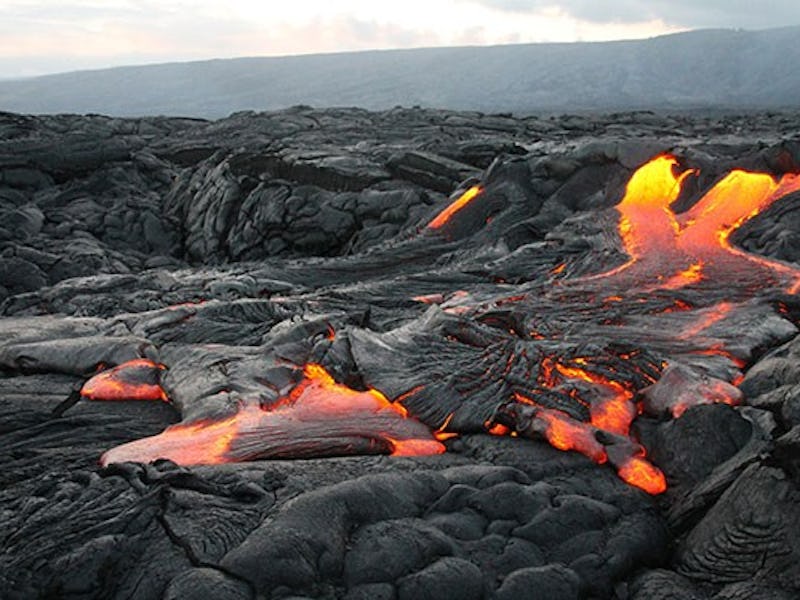A Volcanic Eruption Blew Away the Ozone Layer in the End-Permian Extinction
It was not a good time to be alive.

Earth was not a nice place to live about 250 million years ago. In a cascade of cataclysmic events, the End-Permian extinction event, aka “The Great Dying,” put the event that killed the dinosaurs to shame.
New research in the journal Nature Geoscience gives insights into the causes behind the Earth’s most devastating mass extinction. The End-Permian event led to the extinction of over 90 percent of all marine life and over 70 percent of all land vertebrates.
In a paper published Monday, an international team of geoscientists presented evidence that a nearly-million-year-long volcanic eruption flooded the Earth’s atmosphere with halogens that depleted the ozone layer, contributing to conditions that made it impossible for most living things to survive.
By analyzing xenoliths from the Earth’s lithosphere — rock between the crust and the mantle that got carried to the surface during an eruption — in the region of the Siberian flood basalts, the researchers found that there had been an extraordinarily high concentration of halogens such as bromine, iodine, and chlorine in the magma stored there.
Since the eruption of the Siberian flood basalts coincided with the beginning of the End-Permian event about 250 million years ago, the researchers realized just how central this eruption was to the chain of events that killed off most life on Earth.
This sample of mantle xenolith is a section of the lithosphere that got captured by passing magma and erupted to the surface during the eruption of the Siberian flood basalts.
“We concluded that the large reservoir of halogens that was stored in the Siberian lithosphere was sent into the earth’s atmosphere during the volcanic explosion, effectively destroying the ozone layer at the time and contributing to the mass extinction,” Michael Broadley, Ph.D., a postdoctoral researcher at the Centre for Petrographic and Geochemical Research in Vandœuvre-lès-Nancy, France, and the paper’s first author, said.
This new insight fits neatly in with what we already know about the End-Permian extinction, in which the eruption of the Siberian flood basalts triggered worldwide consequences that led to plants and animals slowly dying off.
For instance, in a paper published in February in Science Advances, scientists affirmed part of the new findings, showing that decreased fertility in fossilized trees could have very well been caused by a thinning ozone layer.
By growing pine trees under UV light conditions similar to those they faced during the End-Permian extinction, scientists showed that experimental trees’ pollen mutated in the same way that ancient pine pollen mutated. This suggested that, as the ozone layer thinned in the wake of the Siberian flood basalts eruption, trees had a harder time reproducing successfully, which reduced the amount of food for large herbivores, accelerating the rate of extinction over time.
Many scientists say that the Earth is currently in the midst of a sixth mass extinction, but hey, at least it probably won’t be as bad as The Great Dying.
Abstract: Magmatic volatile release to the atmosphere can lead to climatic changes and substantial environmental degradation including the production of acid rain, ocean acidification and ozone depletion, potentially resulting in the collapse of the biosphere. The largest recorded mass extinction in Earth’s history occurred at the end of the Permian, coinciding with the emplacement of the Siberian large igneous province, suggesting that large-scale magmatism is a key driver of global environmental change. However, the source and nature of volatiles in the Siberian large igneous province remain contentious. Here we present halogen compositions of sub-continental lithospheric mantle xenoliths emplaced before and after the eruption of the Siberian flood basalts. We show that the Siberian lithosphere is massively enriched in halogens from the infiltration of subducted seawater-derived volatiles and that a considerable amount (up to 70%) of lithospheric halogens are assimilated into the plume and released to the atmosphere during emplacement. Plume–lithosphere interaction is therefore a key process controlling the volatile content of large igneous provinces and thus the extent of environmental crises, leading to mass extinctions during their emplacement.